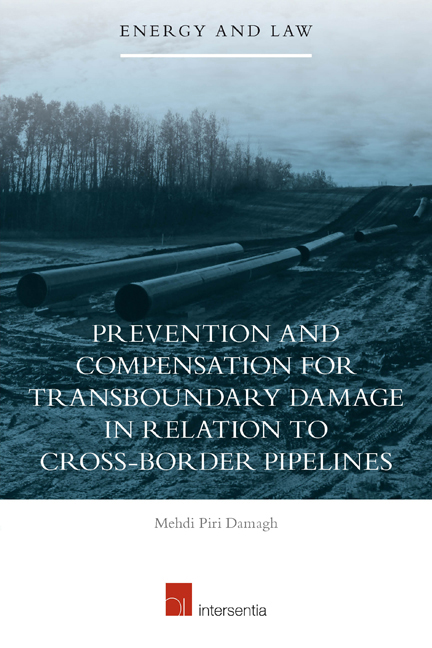Book contents
- Frontmatter
- Dedication
- Acknowledgements
- Contents
- Abbreviations
- List of Tables and Maps
- Chapter 1 Introduction
- PART I INTRODUCTORY ISSUES: PIPELINES, THE NATURE OF RISKS ASSOCIATED WITH PIPELINES AND THEIR REGULATORY REGIMES
- PART II PREVENTION OF CROSS-BORDER PIPELINE ACCIDENTS – MEANS AND SOURCES
- PART III STATE RESPONSIBILITY FOR TRANS-BOUNDARY DAMAGE CAUSED BY PIPELINES
- Summary
- Bibliography
- Valorisation Addendum
- Curriculum Vitae
Chapter 1 - Introduction
Published online by Cambridge University Press: 13 December 2017
- Frontmatter
- Dedication
- Acknowledgements
- Contents
- Abbreviations
- List of Tables and Maps
- Chapter 1 Introduction
- PART I INTRODUCTORY ISSUES: PIPELINES, THE NATURE OF RISKS ASSOCIATED WITH PIPELINES AND THEIR REGULATORY REGIMES
- PART II PREVENTION OF CROSS-BORDER PIPELINE ACCIDENTS – MEANS AND SOURCES
- PART III STATE RESPONSIBILITY FOR TRANS-BOUNDARY DAMAGE CAUSED BY PIPELINES
- Summary
- Bibliography
- Valorisation Addendum
- Curriculum Vitae
Summary
BACKGROUND OF THIS BOOK
By now, most people are aware of the critical issue of supplying energy to sustain the daily life of contemporary societies. Economic growth requires increasing the amount of energy. Fossil fuels are still the primary source of energy and increasingly so. However, these fossil fuels are not valuable when they are far away from consumers. They need to be moved and delivered to consumers to acquire their actual value. There are only a few options available for transporting crude oil and natural gas over long distances. Pipelines are one of the most common means of transporting crude oil and natural gas. Pipelines can be laid on land or underwater.
In fact, pipelines are large-scale projects, which can be laid across international borders. Offshore pipelines have been already laid on continental shelves and in the relatively near future they may be laid on the bed of the high seas. An oil or gas pipeline carrying hazardous substances along hundreds or thousands of kilometres has the potential to create major environmental and safety risks. Such pipelines may pose substantial risks to other countries when they have been laid in border areas or shared watercourses. Therefore, oil and gas pipelines need particular preventive measures to keep them safe and environmentally sound along their entire length, which can be subsea or terrestrial. Environmental damage caused by onshore pipelines does not differ much from other types of trans-boundary environmental damage. Meanwhile, environmental damage caused by offshore pipelines is a different story. Pipelines are fixed assets which can be laid in shared watercourses, continental shelves and high seas. Offshore pipelines therefore may pose significant environmental risks in the form of trans-boundary damage, not only to other countries but also to the common heritage of humankind for a long term.
Furthermore, over long distances, many pipelines traverse international borders to reach their final destinations. A pipeline can be characterized as a cross-border pipeline when it spans international territories or territories belonging to other states. The construction and operation of a cross-border pipeline may pose substantial environmental and safety risks to countries involved in the pipeline project as well as to other countries and to the common heritage of humankind.
- Type
- Chapter
- Information
- Prevention and Compensation for Transboundary Damage in Relation to Cross-border Oil and Gas Pipelines , pp. 1 - 20Publisher: IntersentiaPrint publication year: 2015



